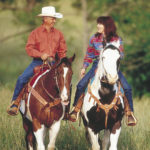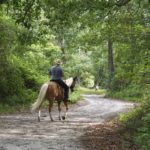If you or an organization to which you belong, decide to host a trail ride, the best advice is plan ahead?way ahead. The amount of planning on the scale of your ride will vary. It generally takes six to 12 months to properly organize a trail ride. However, a one-or two-day ride may be organized in less than three months.

Step 1: Decide what type of ride you want to host.
Do you want to host a single- or multiple-day ride? Consider whom you want to attend, as well as how much time and labor you can devote to the ride. A multiple-day ride requires more planning and labor than does a single-day outing. Similarly, hosting a cross-country ride?one that travels from one campsite to another each day?requires greater coordination than does a cloverleaf ride?one that makes a loop and returns to the same campsite.
When hosting a cross-country ride, you must arrange for multiple campsites. In addition, a crosscountry ride may cross several property lines, requiring permission from each owner. On the other hand, a simple cloverleaf ride enables riders to trailer their horses from home to the campsite each morning, or they can camp without having to travel far. This can be a money-saving alternative for many riders.
Step 2: Choose a season.
The season of the year is an important factor in the type of terrain your ride covers and the riders it attracts. Most rides take place in the spring or fall, when the weather is generally milder. If your ride is too early in the spring, you may encounter rain. If it is too late in the fall, you may find yourself contending with cold weather and snow. Avoiding months prone to extreme heat or cold makes a ride more enjoyable for riders and less stressful on the horses.
Step 3: Secure your campsite.
When choosing a campsite, be sure to consider the number of riders and campers you anticipate attending. Having a campsite with ample parking and wellconditioned access roads for all trucks and trailers isa necessity.
You may also want to consider the campsite?s amenities. The more amenities available, the more convenient it is for riders and support staff.
Your campsite may be on private property or state or federal land. If you wish to camp on private property, you should first obtain permission to use the land. It is advisable to obtain written permission to avoid any misunderstandings. Also, obtain rules from the owner outlining campsite regulations and activities, land and water use, and other specifics.
When camping within a state or federal park or forest, obtain permission from the land manager. This may include obtaining a state or federal land use permit.
You should also request information regarding general horseback riding regulations at the same time. The campsite will likely have specific rules covering land usage and campsite regulations. Certain types of feed and hay may not be allowed within the area. Be sure to include all rules and regulations in the guidelines you provide for the participants of your ride.
Regardless of where you camp, you should obtain necessary documentation covering liability insurance regulations for the public or private campsite and foryour ride. Recreational use statues for private property are also available on the American Association of Horsemanship Safety Web site at utopia.utexas.edu/explore/equine.
A list of national parks that allow horseback riding can be found on the National Park Service Web site at nps.gov/parks.html. Just click on ?Search by Topic.? Select ?Horseback Riding? for the topic search and then indicate the state in which you want to ride.
Step 4: Map out the trails.
Whether you choose to hold a single or multipleday ride, select an area with diverse terrain that will keep each day?s ride interesting and challenging. A spectacular view is a sure-fire way to attract riders.
Ride the entire route beforehand with a small scouting party. During your scouting ride, determine the trail?s level of difficulty, remove any obstacles (if allowed), and identify the safest area for crossing creeks.
Estimate the distance and duration of each day?s ride. You can then give riders an overview of what to expect each day. Keep in mind that a small scouting party will cover the same trail in much less time than will a group of 100 riders. Generally, three to six hours is ample time for rides. Two- to three-hour morning or afternoon rides are also popular.
While scouting, also identify the roadways that are nearest to your trail. Should you have an emergency during the ride, you can accurately and quickly direct an emergency team to your location.
Plan where to take one or more breaks each day in a location that can be reached by truck and trailer, and have a non-riding staff member meet you at this break. If a horse becomes lame, it can immediately be taken back to camp and a substitute horse can be brought in for its rider. The staff member can also return an ill rider to camp.
Step 5: Work out the details.
This includes determining staffing needs, identifying a common area for meetings, outlining procedures and rules, as well as planning meals, entertainment and other details to ensure a safe, successful and fun ride.
Attendance and staffing needs?When planning your trail ride, determine the number of participants the ride can accommodate. It’s advisable to have one staff member or official for every 10 to 15 trail riders. Therefore, if you have only five staff members for your ride, limit the participation to 75 riders.
Your ride staff members should be easily identifiable. Have them wear matching vest, hatbands, bandannas, shirts or other attire of the same bright or distinct color. For groups larger than 30 riders, two-way radios helpstaff members communicate on the trail. The two-way radio allows the ?Drag? (the staff member riding at the end to make sure all gates are closed, etc.) to call aheadto the ?Pace Setter? at the front of the ride and alert him or her of a hold up, for example.
Determine a specific chain of command and an emergency procedure for the ride staff so issues and emergencies can be dealt with quickly and without confusion.
As a safety precaution, at least one staff member should carry basic first-aid supplies for both horses and humans. The same person or another ride staffer should be trained in CPR and emergency first aid.
Another important safety precaution is to notify local authorities of the ride?s daily route so that emergency personnel can find you in case of an accident. For this reason, several ride officials should carry a cellular phone. Also remain aware of where you are riding in relation to roadways.
Designate a secretary to accept payments from and correspond with participants before and during the ride. The secretary can also provide each participant an identification badge. I.D. badges are an inexpensive way to put names with faces, which helps riders get to know one another more easily.
Meal time?When on the trail, riders commonly pack their own meals or are met at meal breaks by a catering truck or chuck wagon. If a caterer is used, plan the day?s ride so that each meal break is taken at a location that is accessible by vehicle. Providing tasty food helps draw participants to a recreational ride.
Special activities?A recreational ride can be more than blazing trails. Many rides include activities for evening entertainment or for non-riding campers. Having a special activity planned can also be useful if the weather prohibits riding. Some popular activities include:
– Horse clinics (riding, care, safety, training)
– Educational programs (area history, local plants and wildlife)
– Games
– Campfire entertainment (sing-alongs, weenie roasts)
– Dances
– Banquets
– Devotional or church services
Step 6: Promote your ride.
You finally have all of the details worked out and your ride is planned. Now it’s time to promote it. Begin promoting your ride at least three months in advance to help ensure a successful turnout.
There are several ways to advertise. Word-of-mouth is the most inexpensive way, but people have to know about the event before they can spread the word.
To promote your ride, consider placing advertisements in these types of publications:
– Recreational riding publications
– State and local livestock publications
– 4-H and local riding club newsletters
You should contact the target publications several months in advance to ensure your information gets there before their publication deadlines. Publications will often list for free the dates, information and contact number for your ride. Another way to get free publicity from magazines and newspapers is by sending them a press release about your ride. A press release should answer six basic questions: who, what,when, where, why and how much? It should also include a contact number so potential riders can call you to ask additional questions.
Create flyers that answer the same basic questions. Flyers are relatively inexpensive to produce and can be posted at:
– Feed, Western wear and tack stores
– Local horse shows and rodeos
– Veterinary clinics
– Horse and livestock auctions
Step 7: The morning of the ride.
You spent months planning, preparing and advertising your ride. You have a great turnout and now it’s time to hit the trail?but there’s still one more thing to do. Before riding out each morning, gather the riders in a central area to make announcements. Designate a central location in the camp ahead of time for this purpose.
If your campground has an arena, this is an ideal gathering area as riders can warm up their horses while waiting for the announcements to begin. You?ll need a public address system or megaphone to go over key points with your riders each day so that they know what to expect.
– Introduce ride officials and staff so that riders know who to ask for assistance.
– Give a brief overview of trail riding rules. If possible, post the rules in the gathering area or provide them to each rider as they check in.
– Encourage riders to warm up their horses and check their equipment before riding out.
– Explain bathroom break procedures.
– Inform the riders of the estimated length and duration of that day?s ride.
– Inform riders of the terrain they will cross, especially that which may pose an obstacle, such as creeks, mountains, steep hills and highways.
– Notify riders of special equipment needs and uses (i.e., breastcollars if that day?s ride involves crossing steep hills, or removing tie-downs before crossing anytype of water).





